Wider And Denser Network
-
- The Evolution of Classification Societies Maritime Logistics Professional, Q2 2014 #42
The role of Classification societies is ever changing, with significant material impact on the maritime market. In this edition, MarPro helps set the stage to and through 2020, with insights from leaders in Class on the burning issues.
What has been the biggest evolution of class in the past five years?
Roberto P. Cazzulo, RINA: Over the past years, there has been a big evolution of class rules into the new Goal Based Standards. The GBS are a way to establish a close link between class rules with goals and functional requirements established by the IMO. Nowadays we are establishing this link for design and construction of new bulk carriers and oil tankers, contracted for construction on or after 1 July 2016. The IACS Common Structural Rules, adopted in December 2013 and that will enter into force in July 2015, will be subject to GBS verification. Within IACS, we are also discussing the development of functional requirements for structural safety of post-Panamax containerships, focusing on hull girder strength and standard load case definitions. This will be another move towards the GBS philosophy in the near future. The GBS approach may also be expanded to look at machinery and automation systems in a holistic way, because they are fully integrated and cannot be seen in isolation, from ship’s performance point of view.
Tim Protheroe, Lloyd’s Register North America: The growth in consultancy is a significant evolution. We are seeing an increased focus on operational performance as well as our core safety role. There’s no doubt that we had been providing this additional support to owners for a long time but now we are seeing the packaging of these services across the board – by class and by other consultants.
Now encompassing myriad roles, what is next for “class?”
Noboru Ueda, ClassNK: I think the biggest change for ClassNK has actually been the expansion of our role from working purely as a regulator, to being an innovator of new technology. The reality today is that we are developing more advanced and rational rules, that are leading to more robust, safer, and more efficient ships but at the same time new regulations and higher standards can also mean greater burdens for shipyards and operators. As organizations dedicated to supporting the maritime industry, it’s not enough to just create better and stricter standards, we also need to proactively innovate new tools and best practices to make it easier for yards and owners to not just reach compliance, but also achieve higher levels and operations.
Philippe Donche-Gay, BV: Three things have changed for classification societies. The range and depth of services they provide, the wider range of clients they provide services to, and the speed and global outreach they have to provide them with. We are delivering more services to more clients in more places more quickly. The logic of this market change means class has to invest more in powerful IT tools and systems and in a global network if they want to stay relevant.
Paal Johansen, DNV GL: Safety remains our priority. Fatality rates are ten times higher in the maritime industry than the norm the OECD (Organization for Economic Co-Operation and Development) applies to land-based industries. The industry has allocated more resources to mitigate individual accident risk than major accident risk. It is time for a change here. We believe that too much confidence on safety procedures excludes more holistic safety methodologies. For instance, the bridge remains mostly an autocratic work environment, one that hinders effective communication. If individuals are blamed for causing accidents, while the underlying causes are more difficult to address, we get the wrong actions. The most important underlying cause, according to statistics, is the interface between systems and humans.
What is the biggest development for so-called IACS quality classification societies in the past year. Are there any game changers looking large in the center porthole?
Donche-Gay, BV: For us the ongoing backwash from the Deepwater Horizon incident is driving more and more need for us to provide services in and grow our expertise in the offshore energy sector.
Ueda, ClassNK: I think by far biggest and most important development for IACS was the adoption of the new harmonized Common Structural Rules (CSR) in December 2013. The new rules not only unify and harmonize the technical requirements of the existing Common Structural Rules (CSR) for tankers and bulk carriers, but also incorporate new requirements for more comprehensive structural analysis at the design stage, as well as new criteria to enhance safety and reliability that will bring the rules in compliance with the IMO’s new Goal Based Standards. The new rules will be applied to all bulk carriers over 90m and all oil tankers over 150m contracted on and after 1 July 2015, and will enable ship designers to work to one common standard applicable to both ship types, resulting in the further enhancement of safety and reliability of the structure. It represents a major step change in ship design that will ensure that new ships are safer and more robust than ever before.
Technology on board vessels is catching up with that ashore and the slowly declining price of bandwidth is making it more attractive and affordable for operators to use SATCOM to harness that technology. Where does class fit into all of that?
Tim Protheroe, Lloyd’s Register North America: Class has to make sure that it understands technology and its implications. The increasing connectivity is very likely to lead to a wide range of implications for shipmanagement. Conversations about the potential for remotely controlled, unmanned ships are being held – is that really possible? Let’s find out. We think class, as ever, has an important role in helping ensure that regulators, owners, designers and managers understand the risks involved with any innovation.
Johansen, DNV GL: This is not directly class related, but we see a growing need for IT security standards, preventing hacking and fraud on a ship/shore IT network.
Donche-Gay, BV: The history of the way IT has changed industries teaches us that we can never predict what IT will do, but we know it will disrupt the existing practices and speed up or eliminate some ways of working. Faster broadband is doing that to lots of industries and it will do that in the marine field. Our role will be to allow that to happen efficiently, and above all, safely. That is what class is about, embracing technological change safely and allowing new developments to move forward with confidence.
Staying on the technology theme, as the industry has been faced with simultaneous regulatory and market pressures over the past five years, what do you consider to be the most influential changes to the vessel and why?
James Watson, ABS: Today, with the increasing emphasis on safety from the environmental perspective, the focus has shifted from structures to systems, looking at optimization of the hull form and of the equipment onboard. Traditional physical model testing remains an essential component of hull form development, but analytical techniques, such as Computational Fluid Dynamics (CFD), have come into their own software able to handle the complex calculations required.
Arriving at the most efficient vessel requires looking at the hull and the associated appendages – propeller, rudder, energy saving devices, bulbous bow (or no bulb) – as a complete and integrated system. This also extends inside the ship to the type of central power plant, efficiency of onboard systems and energy management, fuel choices and measures to reduce consumption, compliance with emission standards for SOX and NOx, ballast water and underwater noise.
This is increasingly facilitated through technologies utilized onboard to monitor, record and assess performance. This sharing of data is also laying the path for a shift in the near future, away from traditional prescriptive requirements towards more risk-based classification activities, such as annual surveys.
Ueda, ClassNK: Without a doubt, the biggest change we’ve seen has been the shift towards more efficient and greener ships. As you say, this is happening both as a result of market forces such as bunker prices, as well as new regulations such as the EEDI. It’s only been a few years since the industry really started to work towards innovating more efficient vessels, but we’re already seeing very impressive improvements in terms of improved fuel efficiency and EEDI scores. At the same time, new GHG reduction technologies like air lubrication, and new low friction paints are just now entering commercial use. We’re now seeing the first fruits of efforts towards GHG reduction, and I think that we’ll see even more impressive technology, and even greater benefits in the years to come.
LNG as Fuel continues to pick up support. Looking at the looming emission and fuel regulations to and through 2020, please comment on how you see “LNG as Fuel” evolving in the coming years?
Johansen, DNV GL: Considering the barriers to LNG as a fuel up until now, we believe that LNG as a fuel is an “all, or nothing at all” proposition. And we have reached the tipping point. It used to be said that LNG was a chicken or egg problem, but in the US we not only have the egg, but the chicken and the henhouse too. As a curiosity, the LNG fuelled ferry operating between Buenos Aires and Montevideo is the worlds´ fastest commercial ship at over 58 knots (classed by DNV GL), and I think this is a good indication also of how fast we will see a change in this field. The growing number of large LNG ready ships currently being built is also evidence of this.
We think North America and then Europe will be the first to get everything in place, soon followed by Singapore, China and Australia. So in 2020, we believe LNG is the standard for short sea shipping in North America and around the North Sea. For deep-sea shipping we believe that some routes between Asia, North America and the North Sea area will have the infrastructure in all ends to support bigger ships. With the infrastructure set to be widely available in 2025, we are already seeing a rush of investments to strengthen this trend.
Watson, ABS: Right now, we see a lot of excitement around LNG as fuel and for good reason. But while it is true to say we are past the initial tipping point, there is still a need for owners to be realistic about the decision to use LNG and the practicalities, once that decision is made. Certainly there is a drive to adopt LNG for reasons of regulatory compliance, primarily in the current ECAs to meet upcoming limits for SOx and NOx and this will radiate out as new ECAs are adopted.
Perhaps as important to shipowners is lifecycle cost in the context of the other solutions available to address the same issues. LNG as fuel is still a big bet, but attractive compared to some other alternatives because it provides a near-single solution. It will meet ECA sulfur emission requirements and depending on type of engine solution selected, may also meet NOx emission requirements.
The decision to go ‘all-in’ on LNG must take into account the vessel design, how it is operated, where and for what length of time. There are multiple design issues associated with making LNG fuel the right solution. In six years I would expect LNG to be available as a marine fuel in at least half a dozen US ports, because by then the ships will have been delivered that require it. Once that happens, I would expect orders for more LNG-fuelled vessels to increase rapidly.
Tim Protheroe, Lloyd’s Register North America: We see an increasingly important future for LNG as a marine fuel and particularly in North America. Right now LNG is being taken up mainly by smaller ferries, by short-haul Jones Act containership operators, and OSVs. Lakes operators are likely to be next. Gas is relatively cheap and abundant in North America – we classed the first LNG carriers and with the largest share of LNG carrier classification we are well placed to offer the gas technology support and risk management that shipping needs as gas-as-fuel evolves. Today, we are involved in LNG-as-fuel projects in North America and around the world. Our work with the Port of Singapore is helping set a template for the development of LNG bunkering in major ports.
Cazzulo, RINA: The use of LNG as fuel is a fundamental matter that will further progress in the next years, in particular for short sea shipping and internal navigation. The NOx Tier III and SOx emission limits in designated ECAs (including North America and US Caribbean Sea) and SECAs (currently the Baltic and North Seas) will drop. Dedicated & reliable emission control technologies, such as exhaust gas recirculation, selective catalytic reduction, scrubbers are needed. Instead, LNG may be used as a viable alternative. However, a lot of issues are to be resolved, both on board, for LNK storage capacity, and ashore, in particular looking at ships’ integration with regasification plants and bunkering stations.
The lines of demarcation between Class and the regulatory community are becoming blurred. Classification Societies now routinely perform many tasks heretofore the exclusive domain of the flag state and the Coast Guard. As this practice widens, how do you maintain your objectivity and more importantly, who is checking now to make sure the job is being done correctly?
Tim Protheroe, Lloyd’s Register North America: LR prides itself on 254 years of Independent Third Party status and is ISO Certified (by BSI). We’ve been performing as RO for about 100 Countries around the globe—doing Statutory work for many decades. So, this is nothing new for us. USCG delegation to Class is a positive for industry safety due to our expertise and flexibility. LR adapts our Rules and Regulations with regularity throughout the year to keep pace with industry technological advances. On the other hand, the USCG admits that a Rulemaking takes at least two years. With delegation to Class, the agency can husband its resources’ on higher priority issues.
Watson, ABS: The trend toward Flag Administrations delegating statutory certification functions to Recognized Organizations (ROs) is not really that new. In fact it began in earnest after the end of World War II and has continued over the years, becoming the norm rather than the exception. The global trend to authorization of ROs was driven by a number of factors, such as the growth in the number of Flag States over the years, driven by rapidly expanding world trade as well as by the classification societies’ expanding global networks of skilled surveyors and engineers which few Flag States could afford to duplicate.
Port State Control (PSC) also plays a key role in checking that the ship has been properly certified by ROs and in so doing provides an indicator on the RO’s performance which is used by many Flag States as a basis to determine their level of RO oversight and monitoring. Within the last decade. PSC regimes have increased in number and now include 10 regimes covering almost all of today’s ports where maritime trade is conducted.
In the US, ABS has had significant authorization to act on behalf of the US Coast Guard since 1981 and this has been progressively expanded over the years. The USCG’s Alternative Compliance Program has now been in place for nearly 20 years. This has always been accompanied by close communications and working relationships between USCG and ABS personnel at all levels, as well as USCG involvement in ABS Rule development, and a robust system of oversight and monitoring of ABS’ activities by the Coast Guard.
Roberto P. Cazzulo, RINA: The job carried out by classification societies is closely scrutinized internally and by many external bodies, including flag Administrations, Port State Controls, the IMO, the European Maritime Safety Agency (EMSA), the EU Quality Assessment and Certification Entity (QACE) and Accredited Certification Bodies (ACBs). The US Coast Guard (USCG) verifies the compliance of its Recognized Organizations (RO), including RINA, as well as plays a leading role to verify vessels heading to US ports, both as Port State and as inspection body, for instance for cruise vessels built in Europe. Findings and recommendations arising from these audits, inspections and controls are carefully considered for continual improvement of our quality management systems. One of the requirements that is more carefully checked is how class societies are able to maintain objectivity and independence of third party assessments, carried out during construction and ship’s survey. Frankly speaking, we are concerned on how to deal with this number of internal and external audits and controls, without undermining the quality of our services.Consolidation within the classification society world has brought together great strengths, but also centered power and influence in fewer organizations. What are the positives for the maritime industry?
Donche-Gay, BV: Consolidation is both normal and desirable in classification. Only global companies can have the resources to invest in the IT and research needed to stay abreast and ahead of new needs for bigger and more efficient ships and more sophisticated offshore energy units. Only a global organization can deliver the services needed quickly wherever they are needed.
Johansen, DNV GL: Stronger companies, with a wider and denser network of stations can serve customers better, and develop distinct strengths and competence.
Ueda, ClassNK: As the maritime industry is truly global, I think the growth and consolidation of classification societies may be a good thing for the industry. A developed global infrastructure allows class societies to support the maritime industry around the world, and also provides the resources necessary to contribute to the entire maritime industry.
Are there roles that Class should not take on? If not, why not?
Johansen, DNV GL: We in DNV GL are very clear on this: We do not design, build or operate assets on behalf of our customers. We contribute with conceptual ideas to the whole industry, but we do not go into detailed design. Neither do we patent technology for commercial use. Instead, we contribute with ideas that we present to the entire industry, in line with our purpose of safeguarding life, property and the environment.
Philippe Donche-Gay, BV: We feel uncomfortable when we see class societies claiming to create a new design and then approve the same design wearing another hat.
Noboru Ueda, ClassNK: One criteria of membership in IACS is that every member maintains “independence from ship-owning, ship-building and other commercial interests which could undermine the Classification Society’s impartiality,” and I think it is essential for class societies to maintain our independent and third party status in this regard. At the same time, however, for ourselves at ClassNK we believe that the very purpose of classification is to contribute to the development of the maritime industry, including not only ocean-going vessels, but also inland and coastal shipping, as well as the offshore sector. That is the basis for all of our work and development as an organization. Whether it be developing new services for shipyards or owners, improving our service and quality, or conducting R&D, everything we do is dedicated to protecting life and property at sea, protecting the marine environment and supporting the maritime industry, and I expect that to continue in the future.
Tim Protheroe, Lloyd’s Register North America: Class is class and needs to be seen as such. Classification should not be confused with consultancy services offered by organizations that also offer classification services.
Looking globally, what do you consider to be the top two or three regulatory issues that will have the deepest impact on the maritime world, and why?
Johansen, DNV GL: First, the stricter environmental regulation that we have touched upon. Secondly, the Maritime Labour Convention of 2006 (MLC 2006). While not having much impact yet, we believe MLC 2006 will shape for instance the interface between systems and humans, and new ways of looking at human factors to increase safety.
Watson, ABS: Two regulatory issues which are particularly challenging for owners of existing ships are ballast water treatment and air emissions regulations. Another very challenging issue for operators of existing ships is in meeting the limits on SOx and NOx emissions in IMO Emission Control Areas (ECAs). For many ships, compliance with SOx emission limits will require the fitting of multiple fuel oil systems and adjustments to engine systems and lubricants, or the fitting of exhaust gas cleaning systems or most radically, conversion to the use of LNG as a fuel.
For new ships, constructed on or after 1 January 2016, meeting the Tier III engine requirements for NOx emissions, may also be a significant issue, though the implementation date for these controls may be extended by IMO. The Tier III requirements call for approximately an 80% reduction in emitted NOx in relation to Tier I engines and may require the use of specialized emission reduction technologies such as water injection/humid air engines, exhaust gas recirculation, or selective catalytic reduction systems. Compliance with SOx and NOx emission limits – not to mention the adoption of ballast water management practices - therefore present the prospect of considerable capital outlay and increased operational costs over the medium term.
Looking a bit further to the future, the progressive tightening of the Energy Efficiency Design Index (EEDI) requirements in phases over the next decade, will effectively require progressive reductions in CO2 emissions from new ships. This, the high cost of fuel and the possibility of future market-based measures to specifically limit emissions of greenhouse gases, are driving research and innovation to make ships ever more energy efficient.
(As published in the 1Q 2014 edition of Maritime Professional - www.maritimeprofessional.com)
-
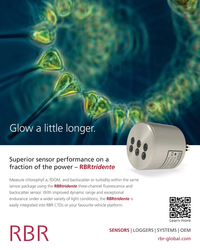 )
March 2024 - Marine Technology Reporter page: 4th Cover
)
March 2024 - Marine Technology Reporter page: 4th Coverand ynamic range and exceptional backscatter sensor. With improved dynamic range and exceptional ght conditions, the RBRtridente is endurance under a wider variety of light conditions, the RBRtridente is easily integrated into RBR CTDs or your favourite vehicle platform.ur favourite vehicle platform. Learn
-
 )
March 2024 - Marine Technology Reporter page: 25
)
March 2024 - Marine Technology Reporter page: 25ecosystems, providing a new ment and recovery both in Tonga and the ter volcanoes. “We can use hydrophones baseline for monitoring future recovery. wider Paci? c Ocean. Mackay, who spe- to detect submarine landslides as well “Preliminary water column data from cializes in sea? oor mapping techniques
-
 )
March 2024 - Marine Technology Reporter page: 20
)
March 2024 - Marine Technology Reporter page: 202024 Editorial Calendar January/Februay 2024 February 2024 March/April 2024 Ad close Jan.31 Ad close March 21 Ad close Feb. 4 Underwater Vehicle Annual Offshore Energy Digital Edition ?2?VKRUH:LQG$)ORDWLQJ)XWXUH ?2FHDQRJUDSKLF?QVWUXPHQWDWLRQ 6HQVRUV ?6XEVHD'HIHQVH ?6XEVHD'HIHQVH7KH+XQWIRU ?0DQLS
-
 )
March 2024 - Marine Technology Reporter page: 19
)
March 2024 - Marine Technology Reporter page: 19the advan- Another unique aspect is that FiGS data can be used as part tages of using FiGS, as all connected assets will affect perfor- of a much wider system that incorporates all pipelines and mance of a CP system. subsea structures across an entire ? eld. Combined with new A complete FiGS report
-
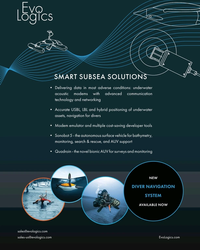 )
March 2024 - Marine Technology Reporter page: 2nd Cover
)
March 2024 - Marine Technology Reporter page: 2nd CoverSMART SUBSEA SOLUTIONS • Delivering data in most adverse conditions: underwater acoustic modems with advanced communication technology and networking • Accurate USBL, LBL and hybrid positioning of underwater assets, navigation for divers • Modem emulator and multiple cost-saving developer tools • Sonobot
-
 )
April 2024 - Maritime Reporter and Engineering News page: 39
)
April 2024 - Maritime Reporter and Engineering News page: 39Tech Files Latest Products, Systems and Ship Designs “Wall Climbing Robot” Danish Pilot calls gets ClassNK Nod LEGO Model "A tribute build to a work life at sea" Image courtesy MOL, Sumitomo Heavy Industries lassNK granted its Innovation Endorse- Image courtesy Espen Andersen/DanPilot ment for
-
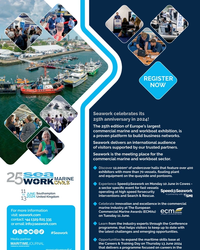 )
April 2024 - Maritime Reporter and Engineering News page: 7
)
April 2024 - Maritime Reporter and Engineering News page: 7REGISTER NOW Seawork celebrates its 25th anniversary in 2024! The 25th edition of Europe’s largest commercial marine and workboat exhibition, is a proven platform to build business networks. Seawork delivers an international audience of visitors supported by our trusted partners. Seawork is the
-
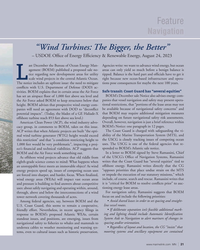 )
April 2024 - Marine News page: 21
)
April 2024 - Marine News page: 21Feature Navigation “Wind Turbines: The Bigger, the Better” – USDOE Of? ce of Energy Ef? ciency & Renewable Energy, August 24, 2023 ast December the Bureau of Ocean Energy Man- Agencies write: we want to advance wind energy, but ocean agement (BOEM) published a proposed sale no- areas can only yield so
-
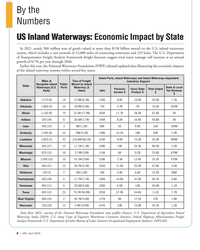 )
April 2024 - Marine News page: 8
)
April 2024 - Marine News page: 8By the Numbers US Inland Waterways: Economic Impact by State In 2021, nearly 500 million tons of goods valued at more than $158 billion moved on the U.S. inland waterways system, which includes a vast network of 12,000 miles of connecting waterways and 219 locks. The U.S. Department of Transportation
-
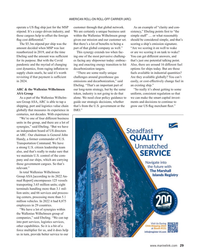 )
February 2024 - Maritime Reporter and Engineering News page: 29
)
February 2024 - Maritime Reporter and Engineering News page: 29AMERICAN ROLL-ON ROLL-OFF CARRIER (ARC) operate a US ? ag ship just for the MSP customer through that global network. As an example of “clarity and con- stipend. It’s a cargo driven industry, and We are certainly a unique business unit sistency,” Ebeling points ? rst to “the those cargoes help to
-
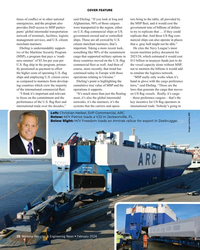 )
February 2024 - Maritime Reporter and Engineering News page: 28
)
February 2024 - Maritime Reporter and Engineering News page: 28COVER FEATURE times of con? ict or in other national said Ebeling. “If you look at Iraq and tors bring to the table, all provided by emergencies, and the program also Afghanistan, 98% of those cargoes the MSP ? eet, and it would cost the provides DoD access to MSP partici- were transported to the
-
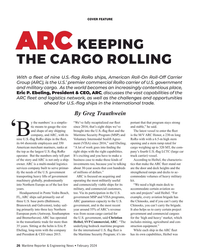 )
February 2024 - Maritime Reporter and Engineering News page: 26
)
February 2024 - Maritime Reporter and Engineering News page: 26COVER FEATURE ARC KEEPING THE CARGO ROLLING With a ? eet of nine U.S.-? ag RoRo ships, American Roll-On Roll-Off Carrier Group (ARC), is the U.S.’ premier commercial RoRo carrier of U.S. government and military cargo. As the world becomes an increasingly contentious place, Eric P. Ebeling, President
-
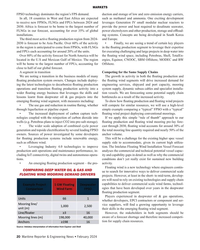 )
February 2024 - Maritime Reporter and Engineering News page: 20
)
February 2024 - Maritime Reporter and Engineering News page: 20and port capacity, mooring operations and transition ? oating production activity into a system supply, dynamic subsea cables and specialist installa- wider ? oating energy business that leverages the skills and tion vessels. We are forecasting some potential supply chain lessons learnt from deepwater
-
 )
January 2024 - Marine Technology Reporter page: 3rd Cover
)
January 2024 - Marine Technology Reporter page: 3rd CoverSMART SUBSEA SOLUTIONS Delivering data in most adverse conditions: underwater acoustic modems with advanced communication technology and networking Accurate USBL and LBL positioning of underwater assets Modem emulator and other cost-saving developer tools Autonomous surface vehicle for bathymetry, monitoring
-
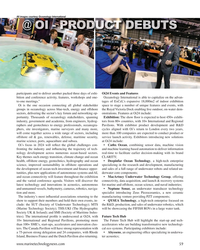 )
January 2024 - Marine Technology Reporter page: 59
)
January 2024 - Marine Technology Reporter page: 59All images courtesy Oceanology International participants and to deliver another packed three days of exhi- Oi24 Events and Features bition and conference activity, features, workshops and one- Oceanology International is able to capitalize on the advan- to-one meetings.” tages of ExCeL’s expansive 18
-
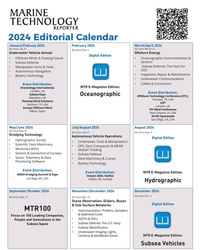 )
January 2024 - Marine Technology Reporter page: 53
)
January 2024 - Marine Technology Reporter page: 532024 Editorial Calendar January/Februay 2024 February 2024 March/April 2024 Ad close Jan.31 Ad close March 21 Ad close Feb. 4 Underwater Vehicle Annual Offshore Energy Digital Edition ?2?VKRUH:LQG$)ORDWLQJ)XWXUH ?2FHDQRJUDSKLF?QVWUXPHQWDWLRQ 6HQVRUV ?6XEVHD'HIHQVH ?6XEVHD'HIHQVH7KH+XQWIRU ?0DQLS
-
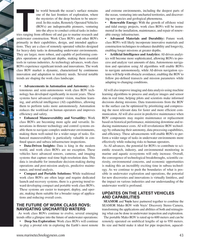 )
January 2024 - Marine Technology Reporter page: 43
)
January 2024 - Marine Technology Reporter page: 43them to navigate complex underwater environments, ogy by enhancing their autonomy, data processing capabilities, making them well-suited for a wider range of tasks. En- and ef? ciency. These advancements will enable ROVs to per- hanced maneuverability is particularly valuable in con- form a wider
-
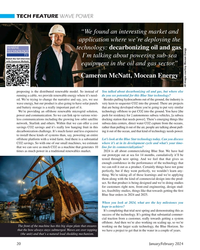 )
January 2024 - Marine Technology Reporter page: 20
)
January 2024 - Marine Technology Reporter page: 20TECH FEATURE WAVE POWER “We found an interesting market and application where we’re deploying the MARINE technology: decarbonizing oil and gas. TECHNOLOGY TV I’m talking about powering sub-sea Watch the full interview with Cameron McNatt: equipment in the oil and gas sector.” Cameron McNatt, Mocean
-
 )
January 2024 - Marine Technology Reporter page: 16
)
January 2024 - Marine Technology Reporter page: 16to support other research vessel operators in utilising water, is a signi? cant shift in operating mode. We are utilising the the MFP and encouraging wider international collaboration. 16 January/February 2024 MTR #1 (1-17).indd 16 1/31/2024 1:00:12 P
-
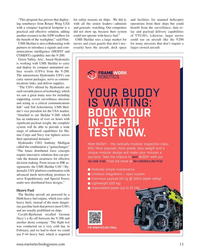 )
January 2024 - Marine Technology Reporter page: 13
)
January 2024 - Marine Technology Reporter page: 13“This program has proven that deploy- for safety reasons on ships. We did it, and facilities for manned helicopter ing sonobuoys from Rotary Wing UAS with all the senior leaders—admirals operations from their ships but could with a compact logistical footprint is a and generals--watching. Our competito
-
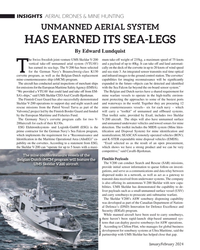 )
January 2024 - Marine Technology Reporter page: 12
)
January 2024 - Marine Technology Reporter page: 12INSIGHTS AERIAL DRONES & MINE HUNTING UNMANNED AERIAL SYSTEM HAS EARNED ITS SEA-LEGS By Edward Lundquist he Swiss-Swedish joint-venture UMS Skeldar V-200 mum take-off weight of 235kg, a maximum speed of 75 knots vertical take-off unmanned arial system (VTUAV) and a payload of up to 40kg. It can take
-
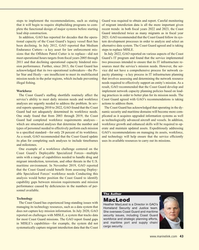 )
January 2024 - Maritime Reporter and Engineering News page: 43
)
January 2024 - Maritime Reporter and Engineering News page: 43steps to implement the recommendations, such as stating Guard was required to obtain and report. Careful monitoring that it will begin to require shipbuilding programs to com- of migrant interdiction data is all the more important given plete the functional design of major systems before starting recent
-
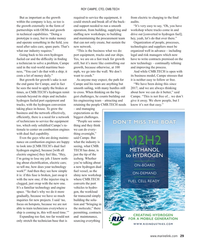 )
January 2024 - Maritime Reporter and Engineering News page: 29
)
January 2024 - Maritime Reporter and Engineering News page: 29ROY CAMPE, CTO, CMB.TECH But as important as the growth required to service the equipment, it from electric to charging to the fnal within the company is key, so too is could stretch and break all of the back- audits. the growth externally in the form of end support needed to run a smooth “It’s very
-
 )
November 2023 - Marine Technology Reporter page: 4th Cover
)
November 2023 - Marine Technology Reporter page: 4th Covertraditional CTDs and is unaffected by surface contaminants or freezing conditions. This enables longer 3 deployments or high-resolution sampling in a wider range of environments. The RBRlegato C.T.D can also control additional sensors to simplify integration, con?guration, and data management. SENSORS
